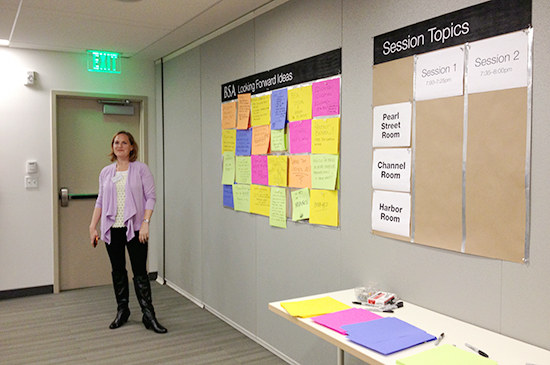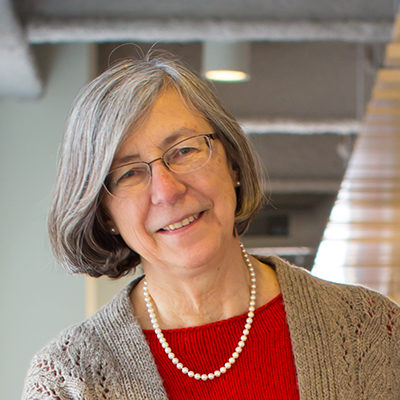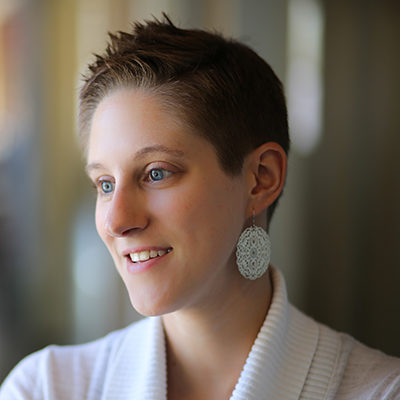
Last night we attended a BSA leadership event, “Looking Forward” with Emily Grandstaff-Rice, president elect of the BSA. Emily brought together BSA leaders and activists to discuss future priorities of the organization. Breaking from tradition of hosting day-long retreats, Emily initiated an unConference, which is a participant-driven event with “rules” like:
- Whatever happens is the only thing that could have happened
- It starts when it starts.
- It’s over when it’s over.
- The Law of Two Feet: If you are not learning or contributing to a talk, presentation or discussion, find a place where you can contribute or learn.
Attending a brainstorming event with these kinds of parameters sets the stage for passionate participation at every level. Participants were encouraged to suggest topics for discussion, the group then voted on the top six topics for the evening. During two time slots, three simultaneous discussions were occurring, from how to bridge the generation gap to what the 21st-century architect looks like. Between the three of us, we attended five sessions.

Tools for 21st Century Architectural Practice
The group was encouraged to imagine very different ways of working in the future, due to ongoing changes in cultural expectations for the workplace. The impact of human endeavor on global ecosystems was emphasized as a new concern that architects must understand and work with in the coming century. Approaches such as cross-disciplinary training and integrated practice were seen as important ways of addressing this concern. Throughout the discussion, the importance of engaging emerging professionals was seen as a key to developing the tools that will be needed.
Engaging the Public with Architecture
Attendees offered a range of ways in which the BSA can enhance the public’s awareness of the role of architects in the built environment. Central to this awareness must be an appreciation of the quality of architectural spaces. The new BSA Space was seen as a big step in this direction. Ideas for exhibits both within BSA Space and at other highly visible locations in Boston were offered. On a more individual level, one participant talked about writing a column on architecture for a local newspaper.
Education + Research
The education and research discussion centered around the question “How do we [architects] branch out beyond the confines of our profession?” The group generally agreed that architects possess a varied skill set, but in many ways are only sharing knowledge amongst themselves, which leads to information siloes and a general public misunderstanding of what architects do or know. Those present for the discussion hoped to see the BSA taking a greater role in two main issues:
1) raising public awareness of architectural-related topics such as sustainability, the urban environment and public art.
2) providing opportunities for architects to teach and publish in non-architectural university and general education programs and journals.
Design Competitions
The discussion about design competitions touched on a number of ideas, beginning with how design competitions could help engage with the City of Boston and better shape the development of land parcels and neighborhoods. The group discussed European cities that have developed through design competitions that bring together architects firms of varied size and resource. Several participants looked for ways the BSA could support more design discourse around specific projects and ideas. We discussed design competitions as a way to raise design discourse in the public eye and bring together architects at all levels of experience. One way to look at a design competition was to think of it as a method for bringing people together, start dialogues about design beyond the profession and share ideas. One of the primary challenges of initiating design competitions is; compensation and the vastly visuals produced by participants; how to level the playing field? Ultimately the group was eager to actively bring design into the public consciousness with conversation and sharing ideas about tangible projects.
Engaging the Emerging Professional
The BSA lacks the involvement of young and emerging professionals. We discussed how people want to work differently; more collaboratively and seek truly interdisciplinary professional environments. While the BSA is more than just architects and its programs offer something for someone at any level within the profession; how can the organization break down barriers? What instills a sense of ownership, commitment and belonging in an individual that makes an organization like BSA essential? There is no quick fix to the issue, but we advocated for building stronger cross-generational relationships. For example, if more BSA leaders used social media networks like Twitter to connect and open conversations with emerging professionals, attending a BSA event may be less intimidating.
The BSA has a lot to look forward to and we’re curious to see where Emily takes the organization in 2014. The “Looking Forward” dialogue didn’t end last night; we want to hear your ideas and there are always more topics to discuss.




